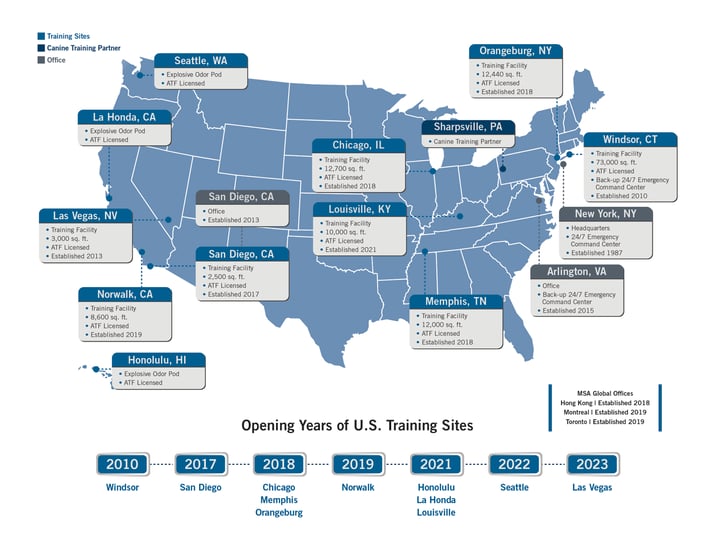The MSA Security® Canine Detection Program is rooted in an unmatched training philosophy and the development of single-purpose, single-handler teams trained exclusively for their intended deployment. MSA bomb-sniffing dogs are at work every day in environments that include sporting and entertainment venues, educational campuses, retail malls, hospitals and medical centers, and more. MSA also trains firearms detection, narcotics detection and technical detection canines.
MSA’s state-of-the-art 73,000 square-foot training facility in Windsor, CT, and numerous regional ATF licensed training centers throughout the country allow teams to be trained and tested as often as once per month. Regular exposure to live explosive odors is critical to maintaining working bomb dogs’ capabilities. Dogs working other deployments, such as firearms detection, receive additional training on odors specific to firearms. MSA’s investment in these regional facilities underscores the company’s commitment to delivering the most effective teams in the private industry.

MSA’s successful Canine Detection Program is rooted in a proven 6-phase training philosophy.

1. Canine Breeding and Socialization: A rigorous vetting process selects only from best-in-class sporting and herding breeds with a keen sense of smell, strong drive, intelligence, stable temperament and eagerness to please. Dogs must also possess an impressive level of existing socialization, which accellerates the training process and yields better results.
2. Canine Imprintation: MSA imprints bomb dogs and firearms detection canines on all five families of commercial explosives, as well as homemade explosives (HMEs) and odors unique to firearms. These pure odors are never “cocktailed” which maximizes olfactory recognition in the field. This is a key industry distinction that requires greater in-house diligence, as well as additional time, resources and expense.
3. Handler Training: Explosive detection and firearms detection canine teams are only as effective as the relationship between the dog and handler. Single-purpose, single-handler teams build and continue to reinforce that special workbond. MSA exclusively recruits canine handlers with military or law enforcement backgrounds, prioritizing candidates with real-world experience in identifying and mitigating security threats.
4. Joint Operational Training: Critical specialty module training focuses on real-life field work and will often directly reflect the dog / handler deployment. Common areas of operational training include: (1) Explosive Odor Tracking, (2) Explosive Cargo Screening, (3) Loading Dock Screening, (4) Checkpoint Screening, (5) Public Transportation Area Screening and (6) Ammunition and Firearms Screening.
5. Testing and Certification: MSA’s Canine Detection Program is consistently evaluated through independent testing and certification on nationally recognized NAPWDA standards.
6. Sustainment Training: Ongoing education and training on the evolving threat spectrum and real-life, real-threat scenarios prepare teams for success in the field.
MSA’s highly acclaimed Canine Detection Program is consistently evaluated to meet the highest level of performance standards and market distinction. All dog / handler teams receive world-class training prior to field work and throughout their careers. Semi-annual training includes explosive identification classes for handlers, which are taught by MSA bomb technicians experienced in the latest explosive threats. While not a requirement, MSA annually administers the Department of Justice National Odor Recognition Test (DOJ NORT) certification for all teams.
To learn more about MSA’s Detection Canine Program, email info@msasecurity.net.
Read more about how MSA Bomb Dogs and Firearms Detection Dogs are working every day to keep people safe in the Detection Dog Spotlights found in our blog library.